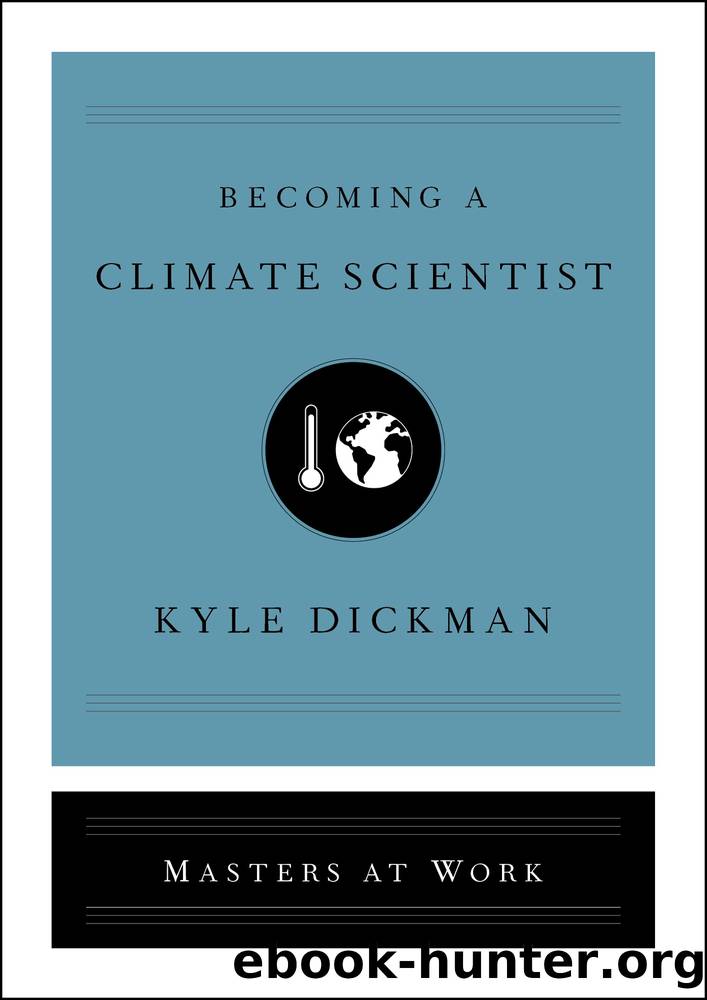Becoming a Climate Scientist by Kyle Dickman

Author:Kyle Dickman [Dickman, Kyle]
Language: eng
Format: epub
Tags: Business & Economics, Careers, General, Self-Help, Personal Growth, Success, education, Counseling, Career Development
ISBN: 9781982142650
Google: GNEDEAAAQBAJ
Publisher: Simon and Schuster
Published: 2021-08-31T23:19:37.580952+00:00
6
Charles David Keeling wasnât the godfather of climate science. Nobody is. But he did more to make the science relevant than anybody before or since. It was the mid-fifties, about two hundred years since humans figured out that burning coal, oil, and other fossil fuels could power the industrial revolution. Keeling, who would soon discover that burning fossil fuels was warming the world, was a scientific nobody. He was a postdoctoral student at CalTech, in Pasadena, California, and transfixed by a debate raging among meteorologists: Was the carbon dioxide released by burning fossil fuels changing the chemical composition of the atmosphere?
The idea that the atmosphere contained invisible materials that kept the world warm was an old one. In the 1820s the French mathematician and physicist Joseph Fourier calculated that given the amount of sun that reaches the earth each day, our world should be a lot cooler than it is. He proposed an idea, later proven correct, that the atmosphere acts like a blanket. When sunlight enters the atmosphere, about a third of it hits clouds or light spots on the earthâlike snow or desertsâand is reflected back into space. But, like sunlight on a black T-shirt, when rays hit the earthâs dark spotsâtrees, dirt, rockâthe warmth gets absorbed, and the earth radiates heat back into the atmosphere in the form of longwave radiation. A percentage of that radiation is then absorbed by carbon dioxide molecules or other greenhouse gases in the atmosphere; these molecules act like bricks in a fireplace by staying warm long after the fire is extinguished. Called the natural greenhouse effect, all that invisible matter keeps global temperatures stable. The greenhouse effect is the reason there is life on our planet. Without it, the temperature of the earth would be â22°F (â30°C).
When Keeling started studying climatology, the field was a dull scientific backwater devoted mainly to compiling statistics from routine weather observations, such as average temperature or precipitation volumes. The debate over carbon dioxideâs role in global temperature was the fieldâs lone flashpoint. One side argued that the earthâs plants, which process CO2 during photosynthesis, and oceans, which absorb CO2, would simply remove whatever extra CO2 man-made devices pumped into the atmosphere. Another widely held position was that the extra CO2 might lead to a small increase in global temperatures. A third, significantly smaller group aligned with Guy Stewart Callendar, a British engineer who had calculated by hand that rising CO2 concentrations would warm the globe significantly. It wouldnât be until the end of the twentieth century, long after Callendarâs death, that climatologyâs leading authorities recognized his stroke of genius. But confirming Callendarâs theory required its own stroke of genius: recording an accurate measure of CO2 concentrations in the atmosphere.
That was Keelingâs gift to science. Back in the fifties, Keeling developed a gas manometer, an instrument that could measure CO2 in the air and water. A lover of the outdoors, he loaded the instrument, his wife, and his infant son into the car and drove Highway 101 south to Big Sur, a remote beach about two hours south of the Bay Area.
Download
This site does not store any files on its server. We only index and link to content provided by other sites. Please contact the content providers to delete copyright contents if any and email us, we'll remove relevant links or contents immediately.
Zero to IPO: Over $1 Trillion of Actionable Advice from the World's Most Successful Entrepreneurs by Frederic Kerrest(4291)
Machine Learning at Scale with H2O by Gregory Keys | David Whiting(4178)
Never by Ken Follett(3790)
Harry Potter and the Goblet Of Fire by J.K. Rowling(3774)
Ogilvy on Advertising by David Ogilvy(3509)
Shadow of Night by Deborah Harkness(3302)
The Man Who Died Twice by Richard Osman(2997)
Book of Life by Deborah Harkness(2867)
The Tipping Point by Malcolm Gladwell(2827)
Will by Will Smith(2792)
0041152001443424520 .pdf by Unknown(2784)
My Brilliant Friend by Elena Ferrante(2773)
How Proust Can Change Your Life by Alain De Botton(2742)
Purple Hibiscus by Chimamanda Ngozi Adichie(2651)
How to Pay Zero Taxes, 2018 by Jeff A. Schnepper(2602)
Hooked: A Dark, Contemporary Romance (Never After Series) by Emily McIntire(2497)
Rationality by Steven Pinker(2291)
Borders by unknow(2227)
Can't Hurt Me: Master Your Mind and Defy the Odds - Clean Edition by David Goggins(2225)
